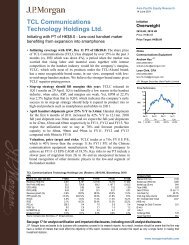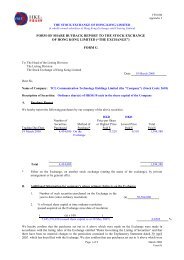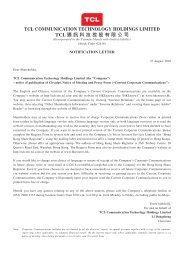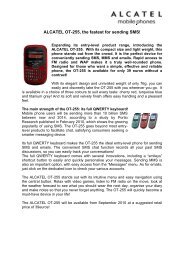2006 - TCL Communication Technology Holdings Limited
2006 - TCL Communication Technology Holdings Limited
2006 - TCL Communication Technology Holdings Limited
You also want an ePaper? Increase the reach of your titles
YUMPU automatically turns print PDFs into web optimized ePapers that Google loves.
<strong>TCL</strong> COMMUNICATION TECHNOLOGY HOLDINGS LIMITED<br />
Notes to Financial Statements<br />
31 December <strong>2006</strong><br />
5. SUMMARY OF SIGNIFICANT ACCOUNTING POLICIES (continued)<br />
Derecognition of financial liabilities<br />
A financial liability is derecognised when the obligation under the liability is discharged or cancelled or expires.<br />
When an existing financial liability is replaced by another from the same lender on substantially different terms, or<br />
the terms of an existing liability are substantially modified, such an exchange or modification is treated as a<br />
derecognition of the original liability and a recognition of a new liability, and the difference between the respective<br />
carrying amounts is recognised in the income statement.<br />
Derivative financial instruments and hedging<br />
The Group uses derivative financial instruments such as forward currency contracts to hedge its risks associated<br />
with foreign currency fluctuations. Such derivative financial instruments are initially recognised at fair value on the<br />
date on which a derivative contract is entered into and are subsequently remeasured at fair value. Derivatives are<br />
carried as assets when the fair value is positive and as liabilities when the fair value is negative.<br />
Any gains or losses arising from changes in fair value on derivatives that do not qualify for hedge accounting are<br />
taken directly to the income statement.<br />
The fair value of forward currency contracts is calculated by reference to current forward exchange rates for<br />
contracts with similar maturity profiles.<br />
For the purpose of hedge accounting, hedges are classified as:<br />
• fair value hedges when hedging the exposure to changes in the fair value of a recognised asset or liability or<br />
an unrecognised firm commitment (except for foreign currency risk); or<br />
• cash flow hedges when hedging the exposure to variability in cash flows that is either attributable to a<br />
particular risk associated with a recognised asset or liability or a highly probable forecast transaction, or a<br />
foreign currency risk in an unrecognised firm commitment.<br />
At the inception of a hedge relationship, the Group formally designates and documents the hedge relationship to<br />
which the Group wishes to apply hedge accounting, the risk management objective and its strategy for undertaking<br />
the hedge. The documentation includes identification of the hedging instrument, the hedged item or transaction, the<br />
nature of the risk being hedged and how the Group will assess the hedging instrument’s effectiveness in offsetting<br />
the exposure to changes in the hedged item’s fair value or cash flows attributable to the hedged risk. Such hedges<br />
are expected to be highly effective in achieving offsetting changes in fair value or cash flows and are assessed on an<br />
ongoing basis to determine that they actually have been highly effective throughout the financial reporting periods<br />
for which they were designated.<br />
Hedges which meet the strict criteria for hedge accounting are accounted for as follows:<br />
Fair value hedges<br />
The change in the fair value of a hedging derivative is recognised in the income statement. The change in the fair<br />
value of the hedged item attributable to the risk hedged is recorded as a part of the carrying amount of the hedged<br />
item and is also recognised in the income statement.<br />
66<br />
Annual Report <strong>2006</strong>








